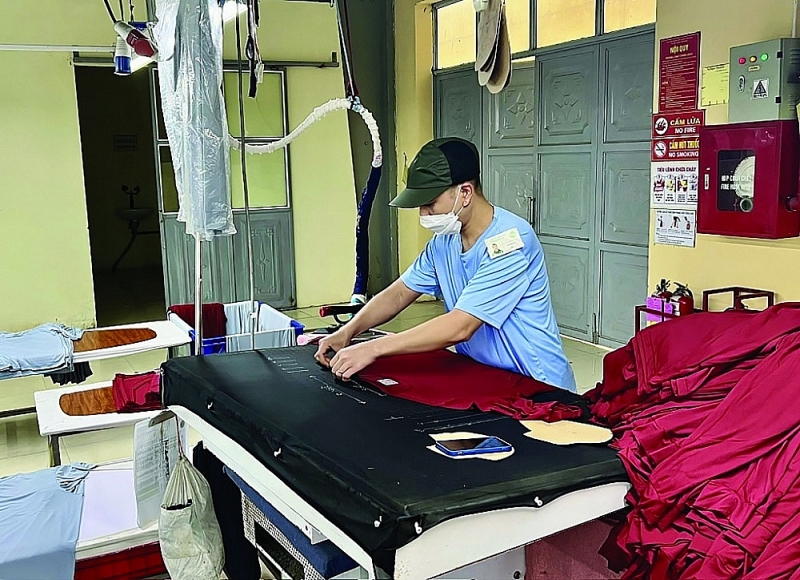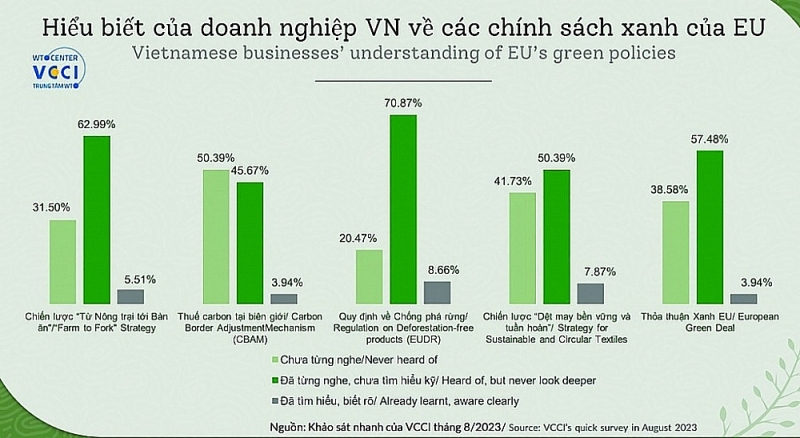Identifying and adapting to the EU Green Deal
The European Union (EU) is always at the top of Vietnam's export turnover. Monitoring and adapting to policies within the framework of the EU Green Deal (The European Green Deal - EGD) is an urgent requirement for manufacturing and exporting enterprises of our country's export to maintain and develop sustainable exports.
 |
|
The EU's green policies with the textile industry are considered more complex and challenging. Image:H.Diu |
Identifying many difficulties and challenges
The EU Green Deal (EGD) is a comprehensive and long-term program to respond to global climate emergencies up to 2050. Adopted on January 15, 2020, the EGD shapes the EU's strategy to achieve the goal of net zero greenhouse gas emissions (emission neutral) and become an economic region that uses the least natural resources by 2050.
According to research by the Center for WTO and Integration under the Vietnam Confederation of Commerce and Industry (VCCI), overall, the EU's green policies are designed to cover many areas. In less than four years of implementing EGD, the EU has had many green policies that are expected to have a direct impact on foreign goods imported into this region.
For example, in the agricultural sector, the "From farm to fork" (F2F) strategy outlines green transformation goals in many different aspects of agricultural and food production and consumption. For the manufacturing and processing sector, the new circular economy action plan (CEAP) lists thirty five policies to build a green, clean, circular economy in seven target product chains (electronics - technology). information technology, batteries and vehicles, packaging, plastics, textiles, construction, food and nutritional products). In addition, there is also a biodiversity strategy, border barbon adjustment mechanism (CBAM), Chemical strategy for Sustainability, consumer waste policies...
In fact, meeting the EU's usual technical standards (TBT), food hygiene and safety, and animal and plant quarantine (SPS) has not been easy, while standards EGD is even stricter, so the EU's green policies will increase "green and sustainable" standards for Vietnamese export goods. Along with that is increasing the financial responsibility of manufacturers for "green and sustainable" goals. At the same time, it requires increased information declaration procedures, accountability when importing, or requires providing information about "green and sustainable" aspects of products to consumers.
With the green policies identified now, Vietnam's export product groups are forecast to be most impacted by the green transition process in the EU market in the coming time including: electrical products, electronics, information technology, machinery, equipment, and related components; agricultural products (especially coffee, cashew, pepper, cocoa, meat,...), seafood, wood and wood products; foods of all kinds (especially organic foods); textiles, footwear; chemicals, fertilizers, batteries, accumulators; iron, steel, aluminum, cement; packaging of all types of products (especially food and chemical packaging).
Mr. Nguyen Van Tuyen, Director of Tien Dat Production, Trade and Services Co., Ltd. said that instead of voluntary standards like before, the EU has legislated to force businesses to comply. Mr. Tuyen said that new export businesses will face cost challenges when they have to invest heavily in technology, raw materials, and production to meet green standards.
Citing an example from his own business, according to Mr. Nguyen Van Tuyen, as an exporter of wood and forest products, to meet the EU's ban on deforestation, the business had to work with import partners. import and have to pay higher costs to import certified wood materials with clear traceability.
Similarly, Mr. Do Tien Trinh, General Director of Vicem Butson Cement Company, shared that businesses must increase the cost of carbon credits from 10-50 Euro/ton of product, and must truthfully declare CO2 emissions, researching and applying many solutions to reduce emissions into the environment such as burning trash to reduce coal burning, using waste sludge to replace clay... Along with that are challenges related to technology and mechanics policy mechanisms to meet standards.
As for textile and agricultural enterprises, the EU's green policies are considered to be significantly more complex and challenging, for example, standards, measures and regulations all affect many stages. in the production chain from design to raw materials, from production, farming to transportation, from use to repair, from disposal to recycling... but not only applicable to the final product.
According to experts, the list of green policies related to imports from outside the EU will continue to be supplemented along with the progress of implementing the goals in the EGD until 2050, especially in the period from now until 2030.
Neutralizing risks, seizing long-term opportunities
 |
Currently, economic difficulties are reducing export output to the EU. According to statistics from the General Department of Customs, in the first nine months of 2023, exports to the EU are estimated to reach more than US $ 32.5 billion, down 8.9% over the same period last year, trade surplus is estimated to reach US $21.4 billion, accounting for proportion of 12.6% of total export turnover. However, this is a very potential market for Vietnamese exports, especially with the opportunities brought by the Vietnam - EU Free Trade Agreement (EVFTA).
Currently, businesses' understanding of EGD is limit ed, so VCCI Vice President Nguyen Quang Vinh said that this is an urgent requirement for Vietnamese manufacturing and exporting businesses to maintain and develop sustainable exports in Vietnam. the EU market in particular and many other markets in general because these markets are also taking green transformation actions in the same direction.
Mr. Nguyen Nam Hai, Chairman of the Vietnam Coffee and Cocoa Association, suggested that although the EU's green transition process creates a step-by-step roadmap to gradually adapt, time is running out when there are changes. The regulations will apply as soon as 2024 or 2025, so management agencies must build a common database for businesses to proactively grasp and deploy promptly.
Prof.Dr. Andreas Stoffers, National Director of FNF Vietnam Institute, said that in order to overcome possible crises and achieve short- and long-term goals, the Vietnamese economy needs to improve its resilience and develop sustainably, in which, moving towards green production and green export is an important factor.
Furthermore, viewed objectively, meeting the EU's green standards and green policies is also an opportunity to help reduce costs and improve business efficiency for businesses in the long term. Not only that, the participation of each enterprise in green transformation will make an important contribution to promoting the green transformation process in the domestic economy; provides some assurance for businesses' ability to export to other developed markets that are also pushing for similar actions.








